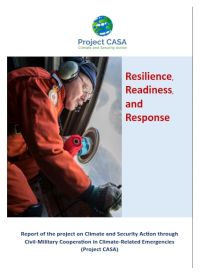Resilience, Readiness, and Response

Report of the project on Climate and Security Action through Civil-Military Cooperation in Climate-Related Emergencies (Project CASA)
Project CASA studies the extent to which several NATO and non-NATO countries have engaged their national militaries in responding to climate-related emergencies. It examines trends in these responses over time, the degree to which national militaries have the resources and mechanisms needed to prepare for and respond to these emergencies, and the consequences for force composition and readiness from participation in civil protection operations.
The project does so through an interdisciplinary network of experts who are working to collect, analyse, and publish data on relevant military activities and civil-military cooperation.The project aims to provide actionable data for decision makers, stakeholders, and the wider public on how militaries are working together with civilian emergency management agencies within countries and across international borders.
This report contains:
- A set of country profiles which explore the Project CASA research questions as they relate to several NATO countries, NATO partners and other countries globally with high climate security risks and/or high civil or military involvement in climate emergencies as well as details on each country’s legal, funding, and operational frameworks and related policies, procedures, and guidelines on military involvement in climate-related emergencies
- The first cross-national dataset on military involvement in climate-related disasters in both domestic and foreign civil protection operations — both for individual countries and comparatively across countries.
- A guide to related international / intergovernmental organizations and mechanisms including several involved in civil-military cooperation.
It concludes with policy options and practical recommendations for relevant EU, NATO, UN, and other institutions, member states and civilian stakeholders with whom militaries interact in emergency response including suggestions for further research and actions to support increased knowledge sharing, cooperation and coordination in the face of growing challenges.
It also highlights good practices that can be advanced from the bottom-up by local authorities and citizens.
>>> READ MORE AND DOWNLOAD THE REPORT >>>
Image credit: Sergeant André Hotton, a search and rescue technician, prepares to release marker streamers from a CC-130 Hercules aircraft on a 2018 exercise. PHOTO: 14 Wing / Government of Canada News Article / October 13, 2020